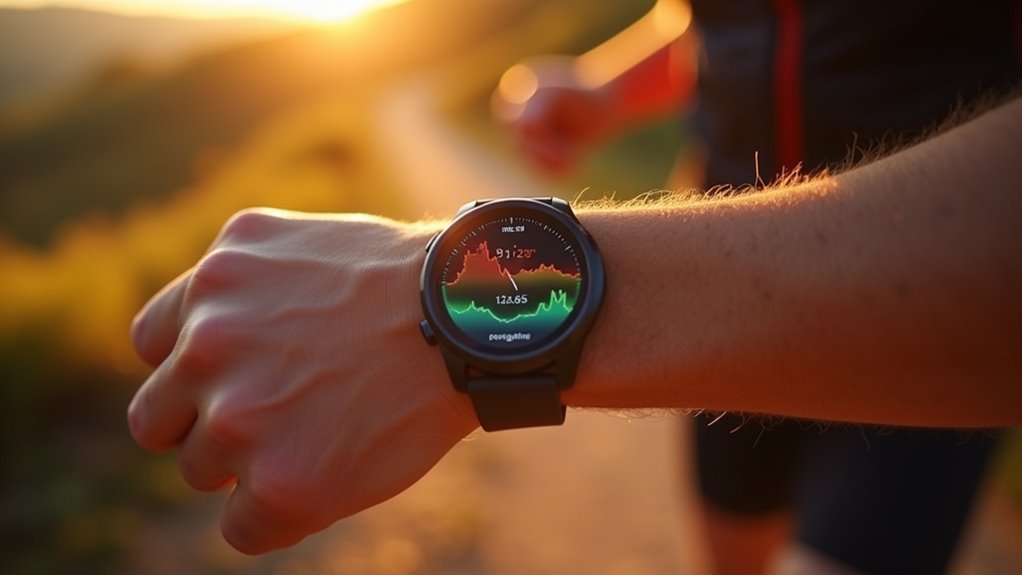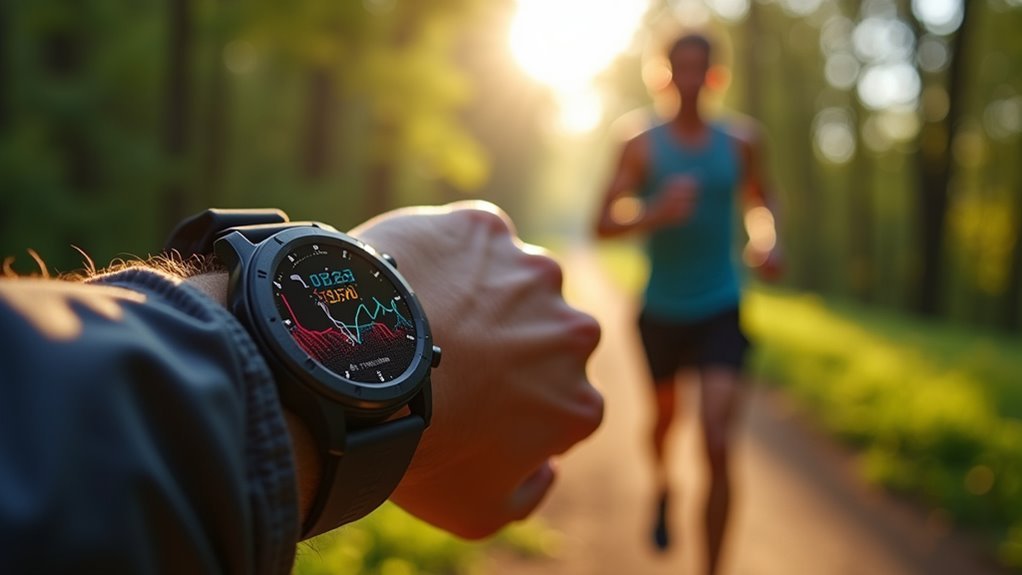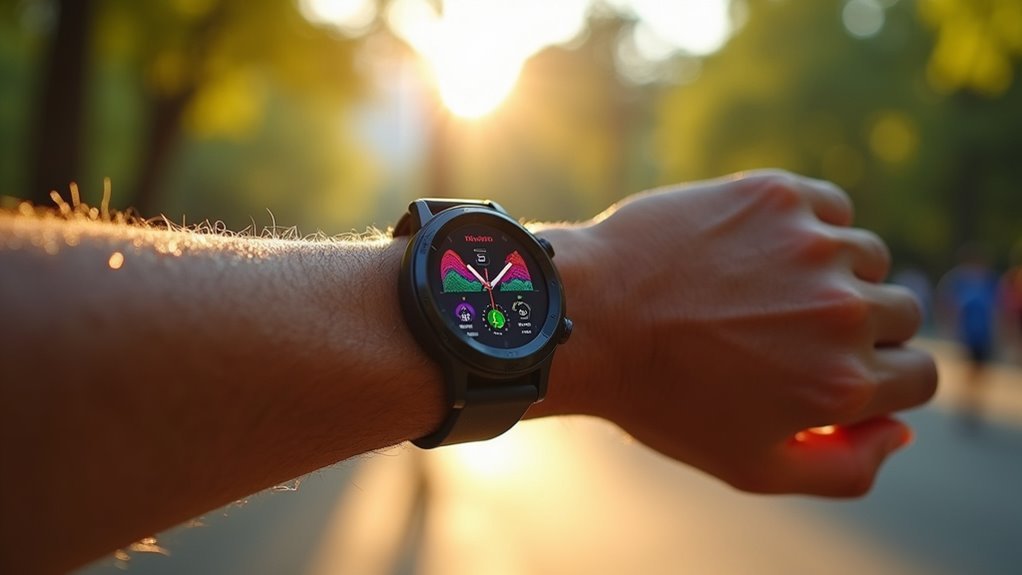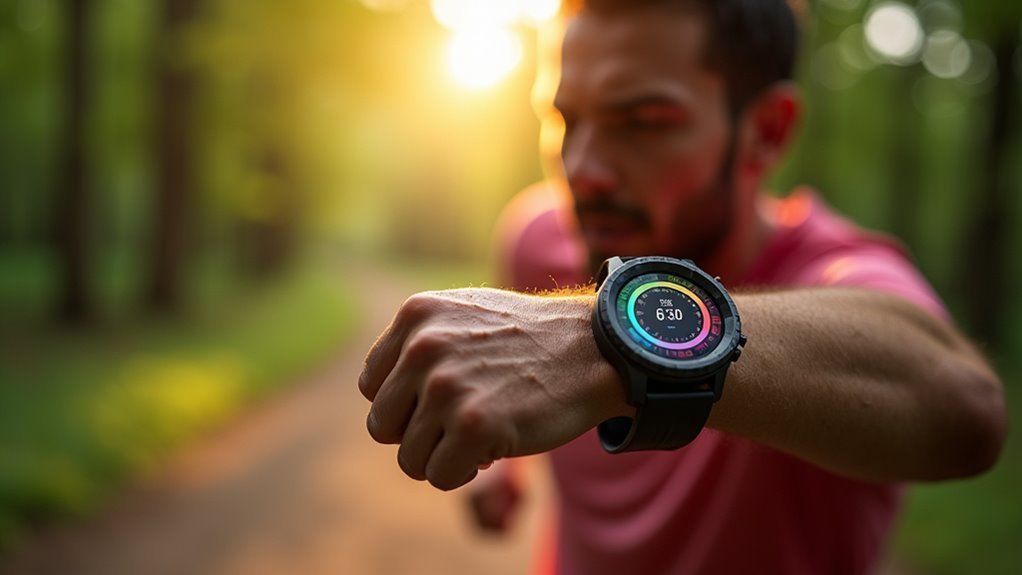Your smartwatch reveals running fatigue through sophisticated biometric monitoring that tracks heart rate variability, skin temperature, and blood oxygen levels in real-time. Advanced AI algorithms analyze these physiological signals to distinguish between agitated and lethargic fatigue types, while GPS data captures declining performance patterns and inconsistent pacing that indicate mounting exhaustion. The device provides personalized recovery recommendations and automatic training adjustments based on your unique fatigue signatures, transforming how you understand your body’s limits and optimize performance.
How Heart Rate Variability Tracks Your Running Fatigue

When you’re pushing through mile after mile, your smartwatch is quietly measuring something far more revealing than your pace or distance—heart rate variability (HRV).
Unlike your heart rate, which simply counts beats per minute, HRV measures the precise variation in milliseconds between each heartbeat. Your autonomic nervous system controls this variability, making it a direct window into your stress and recovery levels.
When you’re well-rested, your HRV values typically run higher. However, as fatigue accumulates from training, those numbers drop considerably. This happens because your stressed nervous system produces less variability between beats. To get reliable readings, your smartwatch needs to monitor for 2 to 5 minutes to calculate an accurate average.
Biometric Sensors That Monitor Real-Time Exhaustion Levels
Your smartwatch combines multiple biometric sensors beyond heart rate to create a thorough picture of your running fatigue through advanced heart rate variability analysis.
These sensors work together through multi-sensor data integration, processing signals from skin temperature, galvanic skin response, and blood oxygen levels to detect exhaustion patterns you might miss on your own. This continuous evaluation helps identify early signs of fatigue before they become performance-limiting factors.
When fatigue thresholds are reached, real-time fatigue alerts notify you immediately, allowing you to adjust your pace or take recovery breaks before you push too hard.
Heart Rate Variability Analysis
Heart Rate Variability (HRV) represents one of the most sophisticated biometric indicators your smartwatch can monitor to detect real-time exhaustion levels during running.
Unlike simple heart rate tracking, HRV measures variations between heartbeats, revealing your autonomic nervous system’s balance. When you’re well-recovered, you’ll see higher HRV values indicating readiness for intense training. Conversely, low HRV signals fatigue and elevated stress levels.
Your smartwatch analyzes multiple HRV features through advanced algorithms that can classify fatigue states with remarkable accuracy. For optimal results, take HRV measurements at the same time daily, preferably in the morning before daily stressors impact your readings.
This real-time feedback allows you to adjust your effort before reaching excessive exhaustion. While sensor variability and movement artifacts can affect reliability, consistent monitoring reveals trends that help prevent overtraining and optimize your performance sustainably.
Multi-Sensor Data Integration
While HRV provides valuable insights into your autonomic nervous system, modern smartwatches achieve far greater accuracy by combining multiple biometric sensors into a unified fatigue monitoring system. Your device simultaneously tracks ECG for cardiovascular strain, EMG for muscle electrical activity, skin temperature changes, and respiratory patterns.
This multi-modal approach creates a thorough fatigue profile that’s far more reliable than single-sensor measurements.
Machine learning algorithms analyze these integrated data streams in real-time, detecting subtle patterns that indicate developing exhaustion before you consciously feel it. The system combines motion data from accelerometers and gyroscopes with physiological signals, monitoring everything from your running cadence to ground contact time. These remote sensor technologies represent a frontier in preventive healthcare, enabling continuous health monitoring that extends far beyond traditional athletic applications.
- Real-time feedback enables immediate training adjustments based on thorough fatigue analysis
- Predictive algorithms identify fatigue patterns before performance degradation occurs
- Biomechanical integration correlates movement efficiency with physiological stress markers
Real-Time Fatigue Alerts
As fatigue begins to settle into your muscles and cardiovascular system, your smartwatch’s network of biometric sensors springs into action, delivering immediate alerts that can prevent dangerous overexertion.
Your device continuously transmits PPG readings tracking heart rate variability, ECG data capturing subtle cardiac changes, and EMG signals monitoring muscle activity. When these metrics cross predefined thresholds, automated alerts trigger instantly through vibration feedback on your wrist.
Cloud-based analytics process this data remotely, enabling enterprise-level fatigue management for teams. The system minimizes false alarms by cross-validating multiple sensor signals through supervised machine learning algorithms.
You’ll receive customizable alerts adjusted to your individual fitness levels, providing early warning signs of elevated heart rate or increased muscle fatigue that help optimize training and reduce injury risk. Advanced systems can even provide Fatigue Forecasts that predict your energy levels for the coming hours based on sleep patterns and physiological data.
AI-Powered Analysis of Your Fatigue Patterns
Your smartwatch’s AI doesn’t just collect data—it learns your unique fatigue patterns through machine learning algorithms that analyze heart rate variability, skin temperature, and movement patterns.
These sophisticated models can distinguish between different types of exhaustion you experience, whether you’re feeling agitated or lethargic after a tough workout.
Based on this personalized analysis, your device provides tailored recovery recommendations that adapt to your specific physiological responses and training history. Studies show that smartwatches achieve correlation coefficients above 0.90 when predicting running performance across different distances.
Machine Learning Pattern Recognition
When you lace up your running shoes, your smartwatch begins collecting a complex web of physiological data that machine learning algorithms can transform into precise fatigue predictions. Your device monitors heart rate variability, movement patterns through IMUs, and activity intensity to identify fatigue signatures unique to your body.
These supervised learning models achieve accuracy rates ranging from 70% to 100%, using binary classification to distinguish between fresh and fatigued states. The algorithms analyze real-time ECG features and correlate them with your historical performance data.
However, you’ll encounter challenges with data quality and model generalizability across different running conditions. Your smartwatch’s machine learning capabilities enable immediate fatigue detection, allowing you to adjust your training before exhaustion sets in. The technology provides continuous monitoring advantages over traditional self-reported fatigue scales that can only capture intermittent snapshots of your exertion levels.
- Pattern Evolution: Algorithms learn your individual fatigue signatures over time, improving prediction accuracy
- Multi-Sensor Fusion: Combines heart rate, movement, and activity data for thorough fatigue assessment
- Adaptive Learning: Models continuously adjust to your changing fitness levels and running conditions
Personalized Recovery Recommendations
After identifying your specific fatigue patterns through machine learning analysis, AI algorithms move beyond simple detection to deliver targeted recovery strategies tailored to your unique physiological state. Your smartwatch differentiates between agitated fatigue (sympathetic nervous system related) and lethargic fatigue (parasympathetic nervous system related) through heart rate variability analysis.
| Fatigue Type | Recovery Focus | Dietary Recommendation | Exercise Adjustment |
|---|---|---|---|
| Agitated | Calm nervous system | Magnesium supplementation | Reduce intensity 20-30% |
| Lethargic | Boost energy naturally | Specific amino acids | Light activation exercises |
| Mixed | Balanced approach | Balanced nutrition plan | Modified intervals |
| Overreached | Complete restoration | Anti-inflammatory foods | Active rest only |
The system continuously monitors your biomedical signals, adjusting recommendations based on real-time data streams. This prevents symptom exacerbation while optimizing your recovery timeline through personalized lifestyle modifications. Research involving university students has validated the effectiveness of this approach in real-world conditions over extended periods.
GPS Data Reveals Performance Decline From Tiredness

As fatigue sets in during your runs, your smartwatch’s GPS data captures telltale signs of declining performance that you mightn’t immediately notice. Your device records real-time pace reductions linked to muscle exhaustion, showing gradual speed decreases that indicate mounting tiredness.
The GPS tracking reveals inconsistent pacing patterns as you struggle to maintain steady effort levels. Modern running watches achieve over 97% accuracy in detecting these performance changes, making them reliable fatigue indicators.
When combined with heart rate sensors, GPS data provides thorough fatigue assessment. Your watch’s elevation tracking also shows how tiredness impacts your uphill and downhill running efficiency, while repeated marathon data reveals cumulative fatigue effects on your overall performance parameters. Advanced models offer enhanced GPS accuracy through dual-frequency positioning systems that better capture subtle performance variations during fatigue.
- Real-time awareness: GPS delivers instant feedback allowing you to recognize early fatigue signs before they greatly impact your run
- Objective measurement: Distance and pace data provide concrete evidence of performance decline rather than relying on subjective feelings
- Long-term patterns: Accumulated GPS data reveals your personal fatigue progression, enabling proactive training adjustments and injury prevention
Distinguishing Between Agitated and Lethargic Fatigue Types
Your smartwatch doesn’t just detect when you’re getting tired—it can actually identify what type of fatigue you’re experiencing. By analyzing physiological parameters like heart rate variability, electrodermal activity, and respiratory patterns, your device can distinguish between agitated and lethargic fatigue states.
| Fatigue Type | Key Indicators | Smartwatch Metrics |
|---|---|---|
| Agitated | Tension, irritation, restlessness | Increased EDA, elevated heart rate |
| Lethargic | Low energy, apathy, decreased motivation | Reduced HRV, lower activity levels |
Machine learning algorithms process this data in real-time, recognizing behavioral patterns like changes in your running form or stride consistency. When combined with EEG-capable sensors, these devices can monitor brain activity changes that differentiate mental strain from physical exhaustion, enabling more precise fatigue classification. The time domain parameters measure variance in your interbeat intervals to filter out measurement artifacts and provide more reliable fatigue assessments.
Smartwatch Algorithms for Predicting Recovery Needs

While your smartwatch excels at identifying different types of fatigue, it’s the sophisticated algorithms running behind the scenes that determine exactly how much recovery time you’ll need.
These algorithms integrate multiple data streams—your heart rate patterns, GPS tracking data, and accelerometer readings—to create thorough fatigue and recovery models. Machine learning enhances these predictions by analyzing how your body responds to different training loads over time.
However, current recovery algorithms face significant limitations. They often rely on generalized training load models that don’t always correlate with your actual physiological state or subjective recovery feelings. Research has shown that duration and intensity alone fail to fully capture the true difficulty and impact of your workouts.
The heavy dependence on heart rate zones sometimes misses critical neuromuscular fatigue aspects.
- Multi-sensor integration: Your device combines heart rate, motion, and GPS data for holistic fatigue assessment
- Individual variability gap: Algorithms struggle to account for personal recovery patterns and lifestyle factors
- Real-time adaptation needs: Future improvements require dynamic adjustment based on immediate fatigue markers
Personalized Training Adjustments Based on Fatigue Metrics
Recovery algorithms provide the foundation, but the real value emerges when your smartwatch translates fatigue metrics into actionable training modifications. Your device analyzes HRV, sleep quality, and training load to create personalized recommendations that prevent overtraining while maximizing performance gains.
| Fatigue Level | Training Adjustment | Recovery Focus |
|---|---|---|
| Low | Maintain planned intensity | Standard sleep routine |
| Moderate | Reduce intensity 10-15% | Extended warm-up/cool-down |
| High | Easy pace or rest day | Prioritize sleep and nutrition |
| Critical | Mandatory rest | Active recovery only |
These adaptive algorithms compare your current metrics against your personal baseline, not general averages. When fatigue indicators spike, your smartwatch automatically adjusts recommended training loads and suggests recovery protocols tailored to your specific physiological responses. However, measurement errors can occur with sensor technology, potentially leading to misleading fatigue assessments that may unnecessarily alter your training schedule.
Advanced Technologies Shaping Future Fatigue Monitoring
As machine learning algorithms become more sophisticated, they’re revolutionizing how smartwatches detect and predict running fatigue with unprecedented accuracy.
Advanced AI systems like PREDICTS and be.care now process your biometric data to distinguish between different fatigue types—whether you’re experiencing sympathetic-driven agitation or parasympathetic-driven lethargy based on your heart rate variability patterns.
These intelligent platforms create personalized fatigue profiles that adapt to your unique physiological responses over time. You’ll receive predictive analytics that anticipate fatigue spikes before they occur, enabling proactive interventions.
Dynamic feedback loops automatically adjust monitoring parameters as your state changes, while miniaturized sensors capture increasingly precise measurements from your wrist. This approach addresses privacy concerns that arise with traditional camera-based monitoring systems used in other industries.
- Predictive intervention: AI anticipates fatigue before performance decline occurs
- Personalized adaptation: Algorithms learn your unique physiological patterns over time
- Multi-type detection: Systems differentiate between sympathetic and parasympathetic fatigue responses
Frequently Asked Questions
How Accurate Are Smartwatch Fatigue Measurements Compared to Professional Lab Testing?
You’ll find smartwatch fatigue measurements less accurate than professional lab testing. While they’re convenient for real-time monitoring, labs use precise equipment like ECG and gas analysis for thorough physiological data integration.
Can Smartwatches Detect Fatigue in Beginner Runners Versus Experienced Athletes?
You’ll find smartwatches detect fatigue differently in beginners versus experienced runners. Your device picks up fatigue faster in beginners who show quicker heart rate spikes and slower recovery compared to seasoned athletes.
Do Different Smartwatch Brands Provide Consistent Fatigue Level Readings?
You shouldn’t expect consistent fatigue readings between smartwatch brands. Each uses different algorithms, sensors, and metrics—Garmin’s Body Battery differs from Polar’s Recovery Pro, making direct comparisons unreliable.
How Long Does It Take for Smartwatches to Learn Your Fatigue Patterns?
Your smartwatch typically needs 2-4 weeks to learn your baseline fatigue patterns. It’ll require initial calibration periods while continuously monitoring your heart rate, activity levels, and recovery data to accurately detect your personal physiological responses.
What Happens to Fatigue Monitoring Accuracy During Extreme Weather Conditions?
During extreme weather, your smartwatch’s fatigue monitoring accuracy drops considerably. Signal interference, temperature effects, and moisture can disrupt heart rate sensors and motion tracking, making it harder to get reliable fatigue readings.
In Summary
Your smartwatch has become an invaluable fatigue detective, tracking everything from heart rate variability to GPS performance patterns. You’ll benefit from AI algorithms that distinguish between different exhaustion types and predict your recovery needs. As these technologies advance, you’ll receive increasingly personalized training recommendations that’ll help you optimize performance while avoiding burnout. Don’t underestimate how much these devices can transform your running strategy and long-term athletic development.





Leave a Reply